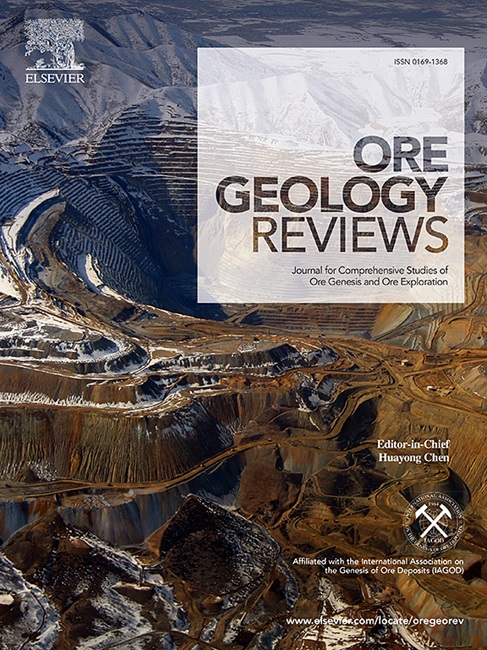Lithium partitioning between aqueous fluids and granitic melt and implications for ore genesis of pegmatite-type Li deposits
IF 3.2
2区 地球科学
Q1 GEOLOGY
引用次数: 0
Abstract
The formation and evolution of pegmatite-related Li deposits usually undergo a magma-hydrothermal transition phase. Yet a crucial question remains unclear regarding the geochemical behavior of Li in a coexisting crystal–melt–fluid systems. Here, a method of synthetic fluid inclusions in silicate glass was used to determine the partitioning of Li between granitic melts and aqueous Cl-bearing fluid (s) at 800 °C, 150 MPa, and the fO2 of the Ni-NiO buffer. Partition coefficients of Li () were calculated from compositions of coexisting fluid inclusions and quenched glasses determined by Laser Ablation Inductively Coupled Mass Spectrometry (LA-ICP-MS). The experimental results show that values exhibit a strong dependence on the fluid compositions, and the values linearly increase from 0.11 ± 0.02 (1σ) to 3.11 ± 0.94 (1σ) with the concentration of NaCl from 0.17 to 3.48 (mol/kg H2O) in the fluid phase. The addition of CO2 into constant aqueous NaCl-bearing fluid results in a pronounced drop in values, dropping from1.83 ± 0.40 (1σ) to 0.42 ± 0.23 (1σ) as the mass fraction of CO2 increase from 0.01 to 0.1. The F contents and aluminum saturation index (ASI) of melt have only a weak impact on values. Our data suggest that the Li partitions into the fluid phase as chloride complex (LiCl0). Numerical modeling indicates that Li in low-salinity (5–7 wt% NaCl, correspond to < 1) magmatic fluids is extracted by excessive fractional crystallization of melt. In relatively high salinity (5–15 wt% NaCl, correspond to ≥ 1) magmatic fluid systems, Li strongly partitioning into fluid phase in a coexisting crystal–melt–fluid system. This process allows the fluids to efficiently extract metal Li from magma and reach a sufficient enrichment, ultimately resulting in the formation of Li-mineralized pegmatites.

伟晶岩型锂矿床水流体与花岗质熔体之间的锂分配及其成矿意义
伟晶岩型锂矿床的形成与演化通常经历岩浆-热液过渡阶段。然而,关于锂在晶体-熔体-流体共存体系中的地球化学行为,仍有一个关键问题尚不清楚。本文采用硅酸盐玻璃中合成流体包裹体的方法,测定了800℃,150 MPa下花岗岩熔体和含水含cl流体(s)之间的锂分配,以及Ni-NiO缓冲液的fO2。通过激光烧蚀电感耦合质谱(LA-ICP-MS)测定的共存流体包裹体和淬火玻璃的组成计算Li (DLifluid/melt)的分配系数。实验结果表明,DLifluid/melt值与流体组成有较强的相关性,当NaCl浓度为0.17 ~ 3.48 (mol/kg H2O)时,DLifluid/melt值从0.11±0.02 (1σ)线性增加到3.11±0.94 (1σ)。在恒定含盐水溶液中加入CO2,随着CO2质量分数从0.01增加到0.1,DLifluid/melt值从1.83±0.40 (1σ)下降到0.42±0.23 (1σ)。熔体F含量和铝饱和指数(ASI)对DLifluid/melt值的影响较弱。我们的数据表明,Li以氯化络合物(LiCl0)的形式进入流体相。数值模拟表明,Li在低盐度(5-7 wt% NaCl)下对应于dlifluid /melt <;1)岩浆流体是通过熔体的过度分步结晶提取出来的。在相对高盐度(5-15 wt% NaCl,对应dlifluid /melt≥1)的岩浆流体体系中,Li在晶体-熔体-流体共存体系中强烈划分为流体相。这一过程使流体能够有效地从岩浆中提取金属锂,并达到充分富集,最终形成锂矿化伟晶岩。
本文章由计算机程序翻译,如有差异,请以英文原文为准。
求助全文
约1分钟内获得全文
求助全文
来源期刊

Ore Geology Reviews
地学-地质学
CiteScore
6.50
自引率
27.30%
发文量
546
审稿时长
22.9 weeks
期刊介绍:
Ore Geology Reviews aims to familiarize all earth scientists with recent advances in a number of interconnected disciplines related to the study of, and search for, ore deposits. The reviews range from brief to longer contributions, but the journal preferentially publishes manuscripts that fill the niche between the commonly shorter journal articles and the comprehensive book coverages, and thus has a special appeal to many authors and readers.
 求助内容:
求助内容: 应助结果提醒方式:
应助结果提醒方式:


